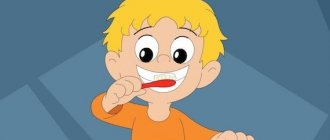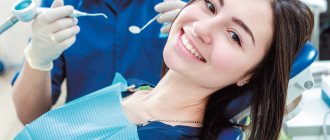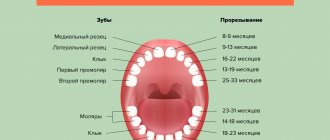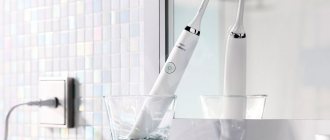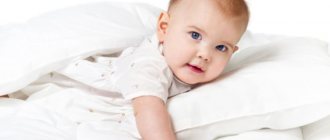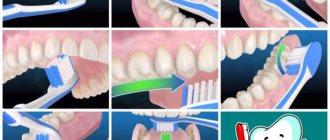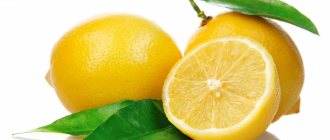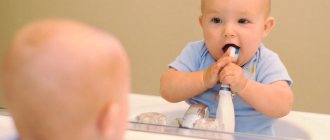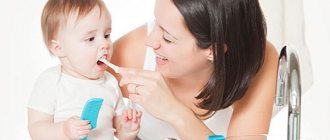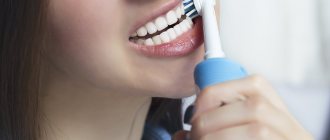Sometimes it can be difficult with children, especially when you need to instill in them certain hygiene skills. It is not easy to teach your child to brush their teeth every day. To make the process easier, try using a dental brushing calendar, which will turn the hygiene procedure into a game and help form a healthy oral care habit for the little ones.
Teeth brushing calendar
How many times a day should you brush your teeth?
Every adult knows: it is necessary to brush your teeth in the morning, before enjoying breakfast, and in the evening, before going to bed. Twice a day is quite enough - this is the opinion of most dentists.
In some cases, doctors recommend that patients use a toothbrush more often. This is required if:
- there is a tendency to carious lesions;
- gums often become inflamed;
- man wears braces.
In such situations, dentists advise brushing your teeth 3-4 times or after each meal. It is especially important to do this if you have a braces system: pieces of food tend to get under the structural elements, as a result of which the enamel deteriorates and caries develops.
Sometimes the teeth have a very thin enamel coating and are sensitive when cold or hot food or liquid enters the mouth. Such crowns are subject to rapid abrasion. To prevent this from happening, brush your teeth more often - in the very initial stages of caries, even self-healing of the enamel layer is possible.
The same rules apply to children. General recommendations: a child should brush their teeth twice a day, but if they have illnesses or have braces installed, then more often.
It is enough for adults to receive information about what measures to take to protect their teeth. For children, you will have to come up with games that transform the cleaning process from a tedious task into an exciting activity.
To ensure that visits to the dentist do not cause unpleasant emotions, but are a regular medical examination without the need to drill out cavities and remove hard plaque, develop a brushing schedule for your child and begin to follow it together.
Caries of baby teeth
Children's teeth have weakly mineralized enamel, especially immediately after eruption. Therefore, they are more vulnerable to decay-causing microorganisms than adult teeth. Decay in primary teeth is usually found in children aged 2-3 years, and in some cases it occurs in children under 2 years of age. Most often, caries affects the deciduous incisors of the upper jaw and the chewing surface of the molars. Particular attention in pediatric dentistry is paid to preventive methods that prevent the occurrence of caries.
Child's visit to the dentist
should occur in the first days after birth. In the future, it is recommended to visit the dentist 2 times a year if the child has no problems with his teeth. If so, then every 3 months. This is much more correct and profitable than treating advanced caries and its complications. During the visit, the doctor will carefully examine the child’s teeth and oral cavity, remove plaque and dental deposits. If there are small carious lesions, the doctor will heal them without waiting for complications. The hygienist will give recommendations on caring for the child’s teeth and oral cavity, and will tell you how to choose the right toothpaste and brush.
Peculiarity of childhood
consists in the rapid occurrence of life processes in the child’s body. Therefore, the development of pathological processes proceeds too quickly. Today you see healthy baby teeth in your child, and a month later you discover caries. The dentist will identify systemic disorders and, if necessary, prescribe the necessary vitamin and mineral complexes and medications. Fluoridation compounds for children's teeth effectively prevent the development of caries. Preventive examinations and professional teeth cleaning will not cause fear in the child and will contribute to a trusting relationship with the doctor. Early diagnosis will allow for simple, painless and inexpensive treatment.
How does caries occur in baby teeth?
A huge number of microorganisms live in the oral cavity. It is necessary to prevent their excessive growth, as this leads to the formation of plaque and then caries. Caries is tooth decay that begins with the dissolution of the mineral substances that make up the enamel. Self-cleaning of teeth is facilitated by saliva, which has bactericidal properties. But plaque still accumulates on hard-to-reach surfaces of teeth, in which bacteria “linger.” Like most children, bacteria have a sweet tooth. They feed on carbohydrates and produce acid, which destroys apatite crystals (tooth enamel is made up of them). These processes are asymptomatic, i.e. without pain. The enamel of baby teeth is very thin, which is why it becomes easy prey for bacteria, which then reach the dentin, the main tissue of the tooth. Dentin is much softer than enamel and therefore deteriorates faster than enamel. Therefore, even with a small hole in the enamel, dentin damage can be serious. This is why carious children's teeth do not look bad for the time being, although the destruction inside the tooth can be great.
Caries of primary teeth can be initial, superficial, medium and deep. With initial caries, white spots of various shapes and sizes appear on the enamel of a baby tooth. Their number may increase. There is no pain. If treatment is not carried out, the process will progress: the spots become dark, brown, black, and the disease can become chronic. With timely treatment, further development of initial caries can be stopped.
Superficial caries is a defect in tooth tissue located within the enamel. A carious cavity can be light or dark. At this stage of the lesion, pain appears when exposed to sweet, sour, salty foods. The treatment method for this form of caries is filling the cavity. In some cases, filling can be replaced by remineralizing therapy.
With average caries, the tooth enamel and part of the dentin are affected. Pain can occur from sweet, salty, cold and hot foods. At this stage, treatment involves treating the carious cavity followed by filling.
In the case of deep caries, the enamel and most of the dentin are affected. The treatment method here depends on the condition of the pulp; it can be filling or conservative treatment.
How long should you brush your teeth?
The frequency of brushing your teeth usually does not raise questions or doubts. How many minutes does it take for it to be successful?
For the youngest, the first procedures should take a few seconds. The mother puts a special plastic finger guard with a tiny brush on one side on her finger and gently massages the baby's teeth.
Finger guard for babies
When should I start doing this procedure? If your baby is 7 months old and his first teeth have erupted, it’s time to start teaching him to brush.
Later, by about two years, you need to accustom your child to the fact that the duration of brushing will be 2-3 minutes.
During this time, you need to have time to clean the chewing surfaces, pay attention to the inside of the teeth and the interdental spaces. Teach your child to gently massage the gums - this is necessary to improve blood circulation in their tissues.
What do we know about baby teeth?
The first milk teeth appear in children from 5 to 8 months . The final growth of baby teeth occurs around the age of three , and the replacement of baby teeth with molars begins at the age of six . The process of changing baby teeth is quite long and can last up to 14 years .
Milk teeth differ from molars , primarily by the lower part of the tooth, hidden by the gum. Baby teeth lack a long root that holds the molar in the gum. Baby teeth are smaller in size than molars. A slight curvature of baby teeth should not cause concern - the position of the teeth can change as the child grows up.
Baby teeth are formed long before birth in the mother's womb . The child takes the substances necessary for this (primarily calcium) from the mother’s body. That is why pregnant women are recommended to take vitamins specially designed for them. If there is a lack of calcium in the mother’s body, her own teeth are in danger of trouble.
How to teach a child to brush their teeth
The best option for forming a sustainable habit in a child of brushing his teeth twice a day is play. How to make your task easier and speed up the process? Try the following methods:
- tell your child an interesting fairy tale in which a toothbrush appears, as well as “bad” and “good” microbes and bacteria;
- brush your teeth with him - let him watch your movements and repeat them; help the child in the process - after all, he does not yet know how to handle a brush;
- buy for your son or daughter “delicious” toothpaste and a brush that has stickers or three-dimensional images of his favorite “cartoon” characters;
- download a special calendar, print it and hang it in a visible place, and so that the baby can easily reach it - we’ll tell you why this is needed below.
Toothpastes that are interesting to children
The main thing is that the child must learn that brushing his teeth twice a day is a necessary part of the regime, just like washing his face after getting up and going for a walk after breakfast. Your task is to make your baby want to brush his teeth - this activity should be interesting for him.
Basic personal hygiene mistakes
The main mistakes in oral hygiene include:
- Wrong size brush: too big.
- Incorrectly selected bristles: too soft or hard.
- Short duration of teeth brushing.
- Incorrect movements of the toothbrush.
- Ignoring tongue cleaning.
Remember, it is difficult to retrain a child to do anything. Therefore, dentists emphasize that it is important to teach proper oral care from early childhood.
Teeth brushing calendar for children
A child of 2 years old does not yet know how to read, but he likes to look at bright pictures and take part in their creation himself - draw, paint.
You need to print any in A4 format or, even better, in A3 format. Children like large, three-dimensional images.
The calendar was invented for those who are not yet familiar with letters. But it will also be interesting for older children, 6–7 years old, since, in addition to pictures, it contains inscriptions and short stories.
It consists of 30 (or 31, depending on the number of days in that month) images of the sun and moon. Every time a child wakes up in the morning and brushes his teeth, he colors one sun. In the evening, before going to bed, the child brushes his teeth and paints over the moon.
This way he will know for sure that not a single ritual has been missed today.
Set aside a place in the bathroom to place your son or daughter’s toothbrush and toothpaste. He should have his own corner in which a beautiful brush and “delicious” paste “live”.
Toothbrush with your favorite characters
To make it easier to consolidate skills, you can involve your favorite stuffed bunny or teddy bear - let them always brush their teeth and paint over pictures on the calendar with your child.
Use Colgate line pastes. This company has developed special children's pastes that:
- not oversaturated with fluorine;
- do not contain harmful substances and are therefore not dangerous if accidentally swallowed;
- have a pleasant taste.
Babies do not yet know how to rinse their mouths and often simply swallow the paste. If they eat some Strawberry or Fruit Flavored Colgate, nothing bad will happen.
Pediatric dentists also recommend ROCS pastes. They are designed taking into account the age characteristics of children: there are Rox pastes for the youngest, from zero to 3 years old, for children from 3 to 7 years old, and for teenagers.
These pastes protect enamel, contain xylitol, which serves to strengthen tooth crowns, as well as probiotics, which support normal oral microflora. Pastes do not cause allergic reactions and do not contain irritating components. Children like the taste of these pastes.
Peculiarities
The doctor will determine how correctly your teeth are being brushed. It is worth making an appointment for children, regardless of the child’s age. Visiting the dentist from an early age helps avoid fear of dental treatment in the future.
Hygiene for children has such features.
- The procedure is carried out quickly (the kids do not get tired).
- Special brushes (with high speed) and pastes are used.
- Remove soft and hard plaque, pigmented plaque, polish the enamel with special pastes;
- After the procedure, the enamel is coated with a special agent (varnish or solution) to saturate the tooth with calcium, fluorine and phosphorus ions.
The pediatric dentist will explain to the little patient in an accessible way how to hold the toothbrush correctly and perform the movements. Parents will be able to learn about the condition of the child’s oral cavity.
Recommendations from Dr. Zubastik
Teaching a child to brush their teeth twice a day is an important task that only parents can solve. Neither kindergarten nor school can help here. Therefore, watch your child: what is more important for him - to see your personal example? Participate in the process of brushing your teeth together? Show creativity - color pictures on the calendar? Use any method that is interesting and enjoyable for the child. Brushing his teeth should become a mandatory daily ritual for him, associated with pleasant emotions. And then caries or stomatitis will not be scary for your baby!
A short video: teaching kids to brush their teeth:
Tags: children, Teeth cleaning calendar, Baby teeth, teeth cleaning
About the author: Dr. Zubastik
Typically, a toothache begins to subside on the way to the clinic and finally goes away after 10 minutes of sitting in line to see the dentist.
- Related Posts
- Waxed and unwaxed dental floss: the difference
- Why get temporary crowns?
- What determines the color of teeth and what shades there are on the Vita scale
« Previous entry
Children's hygiene rules
Parents should consult a professional hygienist. He will show your child the correct technique for brushing his teeth. Child oral care should include:
- Brushing your teeth twice a day.
- Replace your toothbrush 1-3 times a month.
- Using the right paste.
- Storing a clean brush in a special case with the bristles facing up.
- Using dental floss.
- Brushing time is at least two minutes.
- Consuming sweets in minimal quantities.
It is necessary to visit a pediatric dentist once every 4 months, even if there are no dental problems.
Gum care in the first months of life
Caring for a baby's gums in the first months of life is of great importance. Dentistry "Novostom" has prepared a memo for parents.
- After each feeding, wipe the baby's gums with gauze or special wipes.
- Do not put your baby to bed with a bottle of formula (even worse than juice), as they contain a lot of sugar.
- Baby teeth need to be brushed after they emerge. To do this, use a brush or a silicone fingertip (without paste).
- Visit your dentist regularly.
- Get professional teeth cleaning.
Proper oral care in children can eliminate the need for future treatment. Entrust the health of your children to dental professionals.
Cost of children's oral hygiene
| Name | Cost, rub. |
| Comprehensive oral hygiene (deciduous occlusion) 1. determination of the hygiene index. 2. removal of dental plaque with ultrasound. 3. Air flow removal of dental plaque. 4. polishing teeth. 5. training in proper brushing of teeth. 6. recommendations for the selection of oral hygiene products. | 2200 |
| Comprehensive oral hygiene (changeable bite) 1. determination of the hygiene index. 2. removal of dental plaque with ultrasound. 3. Air flow removal of dental plaque. 4. polishing teeth. 5. training in proper brushing of teeth. 6. recommendations for the selection of oral hygiene products. | 3190 |
